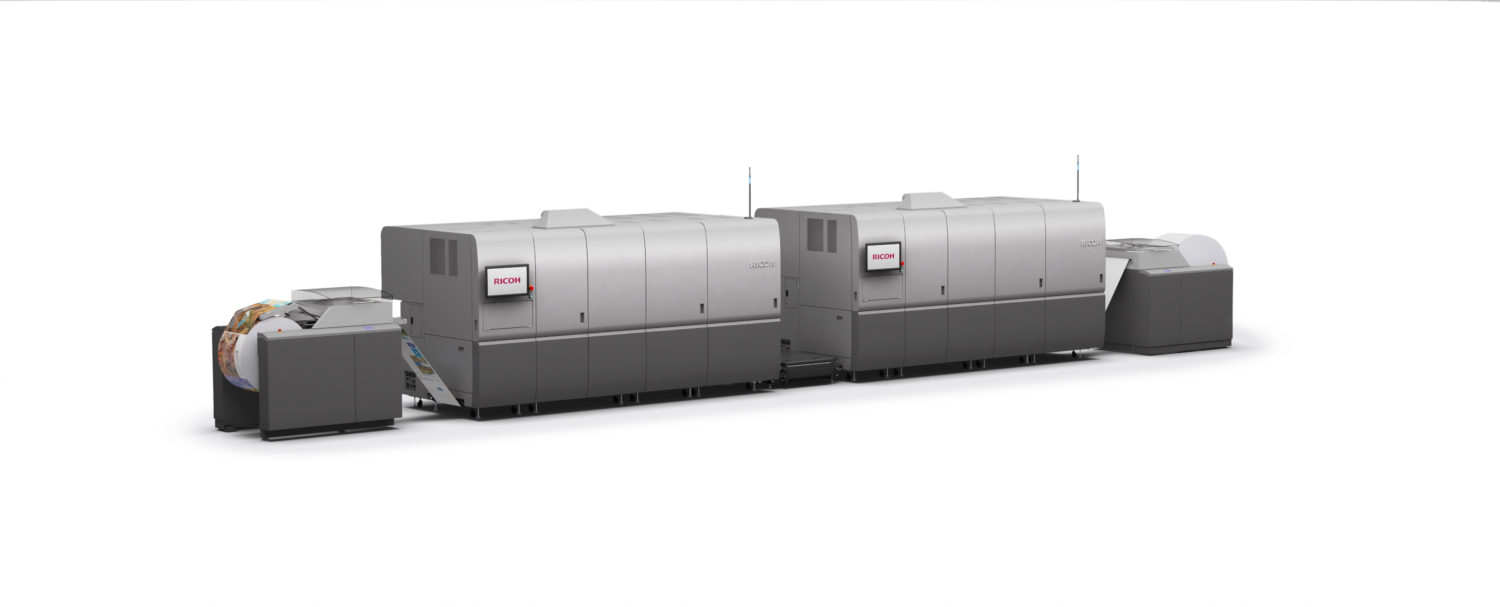Ricoh has expanded its portfolio of inkjet devices targeting the top end of the quality spectrum with the announcement of the Ricoh Pro VC70000 with expected availability in the Q4 2018. Ricoh is reducing barriers for commercial printers considering inkjet by enabling high quality production on offset stocks, including many offset coated stocks without an undercoat or protector coat. (See press release)
I had the opportunity to see the machine in action at Ricoh’s Boulder Colorado Customer Experience Center last week and to learn about some of the innovations that differentiate the Pro VC70000 from the rest of the Pro VC lineup. While visually similar to the VC 60000, the VC7000 offers three key innovations: new ink chemistry, advanced drying technology and finely controlled drop sizes.
Hybrid Ink
The new ink set is a hybrid solvent and water-based pigment ink with light and water fastness similar to offset inks (for indoor applications.) Using less water delivers higher optical density and reduces issues with inter-color bleeding. The characteristics of the ink allow more colorant to remain at the surface of uncoated papers and enable better adhesion to offset coated stocks. They also make the ink more durable, scratch resistant and fade resistant.
Powerful Drying Module
The inks are complemented by new drying technology that enables even high coverage applications to dry quickly. The drying module occupies the same footprint as in other Pro VC models, but includes new air knife technology and an updated drying path. A large external dryer allows the ink to go untouched for a significant period of time before wrapping around a series of 10 heat rollers that are 80 percent smaller than those in other models. The paper is under tension when wrapped around the rollers and the combination of the heat and tension has the effect of virtually eliminating cockle effects from the paper. Ricoh refers to this as “ironing the paper.”
Following drying comes controlled cooling to ensure that paper temperature is reduced to safe levels before hitting the second engine. The platform is equipped with 7 fluid-chilled cooling rollers and high precision monitoring to detect temperature. Speaking of monitoring, fiber optic connectivity is used throughout the device for real-time scanning, analysis and quality control.
Dynamic Drop Sizes
Another important factor driving quality in the 70000 is dynamically generated drop sizes with drops as small as 1.8 picoliters and as large as 23 picoliters enabling both fine detail and efficient coverage. With 4 gray levels, the mechanical resolution of 1200 x 1200 is enhanced to a perceived resolution of 2400 x 2400 for images. The print heads used to generate the 1200 x 1200 resolution are comprised of matched arrays of 600 dpi Ricoh print heads which offers the potential for future speed upgrades as well as lower cost maintenance for individual head replacement. Ricoh employed a similar configuration in the VC6000.
Productivity
The Pro VC70000 is highly productive with speeds of up to 492 feet per minute (note that it will be 15 to 20 percent slower on offset coated stocks) and up to 130,000 A4/letter impressions per hour. It is also highly flexible, supporting a wide array of media with basis weights of up to 260 GSM and as thin as 40 GSM. Ricoh is squarely targeting offset quality applications, such as catalogs, magazines and marketing quality where personalization or job size fit the economics of an inkjet press.
While the device prints natively on a wide variety of offset stocks, Ricoh has included the option for pre-coating and post-coating modules to further extend the range of media or offer additional protection.
Some of the enhancements, such as the drying unit, require more energy at top speed than other Pro VC models, however, the increased energy usage is substantially offset by higher productivity. Overall, the Pro VC 70000 promises to be a flexible and cost efficient press poised to pull page volume from toner and offset devices.

RICOH Pro VC70000
